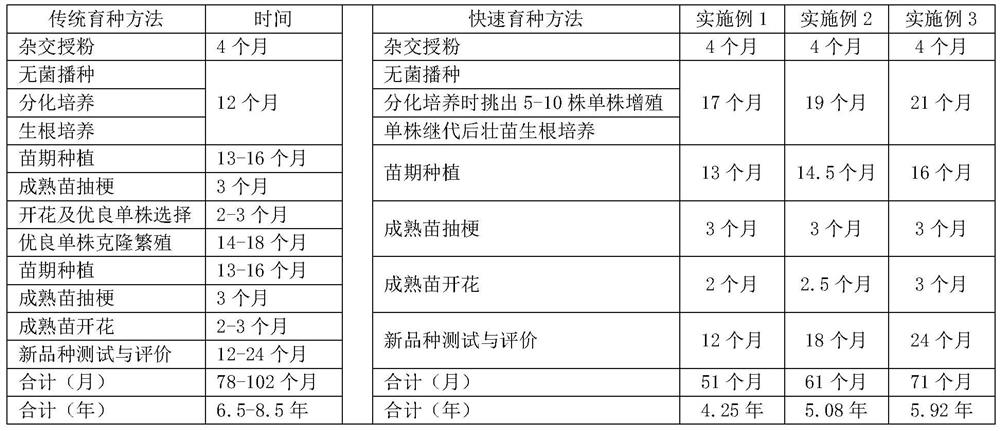Method for quickly breeding new butterfly orchid variety
A new variety, phalaenopsis technology, applied in the field of rapid breeding of new varieties of phalaenopsis, can solve the problem of long breeding cycle of phalaenopsis, and achieve the effect of shortening the breeding time and improving the breeding efficiency.
- Summary
- Abstract
- Description
- Claims
- Application Information
AI Technical Summary
Problems solved by technology
Method used
Image
Examples
Embodiment 2
[0055] (1) Hybrid pollination: female parent is P316, male parent is P25
[0056] Carry out pollination hybridization in February-April, and pollinate 2-3 flowers to ensure the success rate. The temperature is controlled at 28±2°C, the humidity is controlled at 70-80%, and the fruit pods mature about 120 days after pollination.
[0057] (2) Aseptic sowing: Rinse the ripe fruit pods with tap water, soak them in 75% alcohol for 30 seconds on the ultra-clean workbench, and then soak them with 0.1% HgCl 2 The solution was sterilized for 8-10 minutes, rinsed with sterile water for 5-8 times, blotted the remaining water with sterile filter paper and cut the fruit pods, and spread the powdered seeds evenly in the germination medium, the germination medium was Hyponex (flower Bao No. 1) 3.0g / L+NAA (naphthaleneacetic acid) 0.5mg / L+10.0% coconut milk+sucrose 30g / L+agar 7g / L, pH value 5.5-5.8. The culture temperature is 25-28°C, dark culture in the early stage, light intensity 1500-200...
Embodiment 3
[0068] (1) Hybrid pollination: female parent is P25, male parent is HHS
[0069] Carry out pollination hybridization in February-April, and pollinate 2-3 flowers to ensure the success rate. The temperature is controlled at 28±2°C, the humidity is controlled at 70-80%, and the fruit pods mature about 120 days after pollination.
[0070] (2) Aseptic sowing: Rinse the ripe fruit pods with tap water, soak them in 75% alcohol for 30 seconds on the ultra-clean workbench, and then soak them with 0.1% HgCl 2 The solution was sterilized for 8-10 minutes, rinsed with sterile water for 5-8 times, blotted the remaining water with sterile filter paper and cut the fruit pods, and spread the powdered seeds evenly in the germination medium, the germination medium was Hyponex (flower Bao No. 1) 3.0g / L+NAA (naphthaleneacetic acid) 0.5mg / L+10.0% coconut milk+sucrose 30g / L+agar 7g / L, pH value 5.5-5.8. The culture temperature is 25-28°C, dark culture in the early stage, light intensity 1500-2000...
PUM
 Login to View More
Login to View More Abstract
Description
Claims
Application Information
 Login to View More
Login to View More - R&D
- Intellectual Property
- Life Sciences
- Materials
- Tech Scout
- Unparalleled Data Quality
- Higher Quality Content
- 60% Fewer Hallucinations
Browse by: Latest US Patents, China's latest patents, Technical Efficacy Thesaurus, Application Domain, Technology Topic, Popular Technical Reports.
© 2025 PatSnap. All rights reserved.Legal|Privacy policy|Modern Slavery Act Transparency Statement|Sitemap|About US| Contact US: help@patsnap.com

